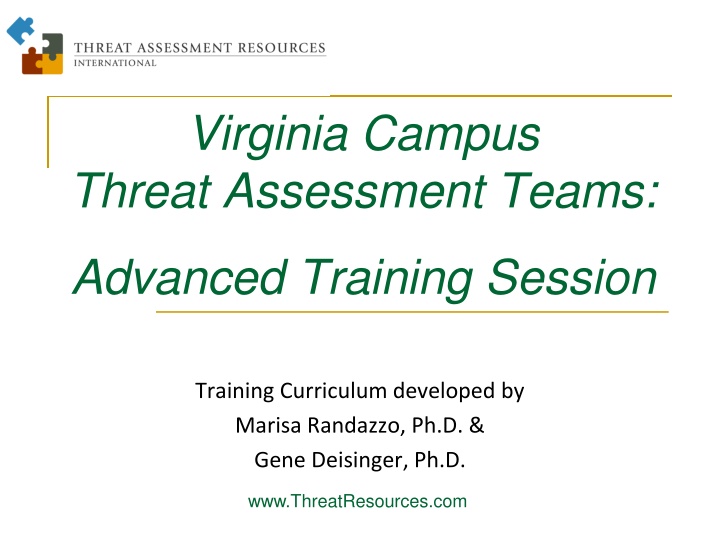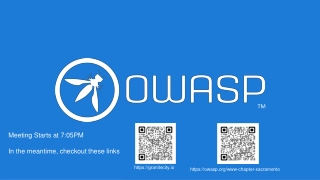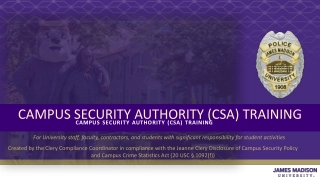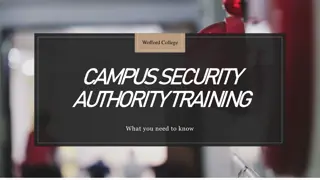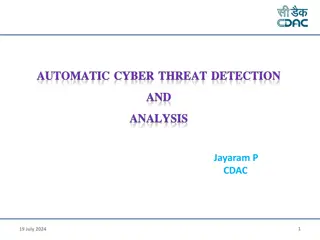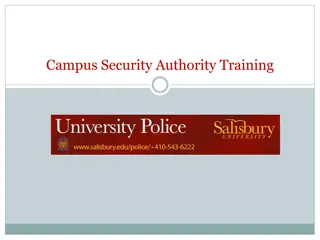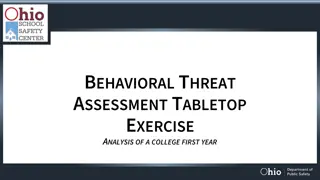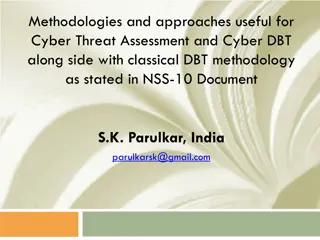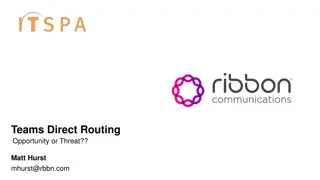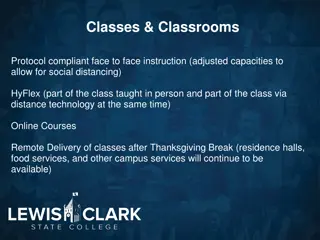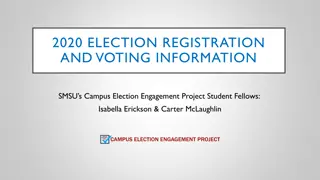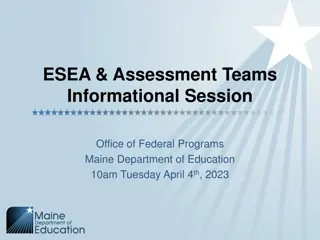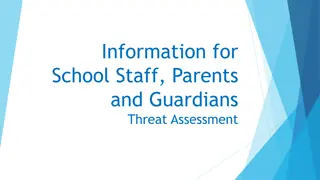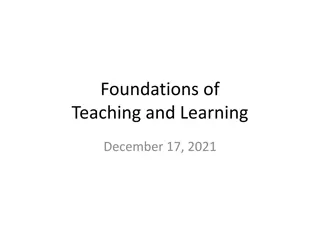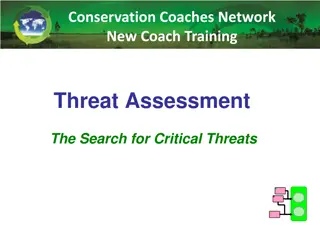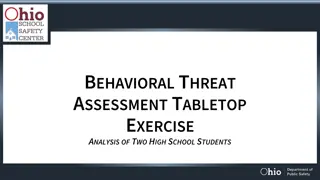Comprehensive Training on Campus Threat Assessment Teams
Explore the advanced training curriculum developed by experts Marisa Randazzo, Ph.D., and Gene Deisinger, Ph.D., for Virginia Campus Threat Assessment Teams. The training covers areas like threat assessment processes, case management, legal updates, and challenges in team implementation. Participants will gain insights into best practices and strategies to enhance campus safety.
Download Presentation

Please find below an Image/Link to download the presentation.
The content on the website is provided AS IS for your information and personal use only. It may not be sold, licensed, or shared on other websites without obtaining consent from the author.If you encounter any issues during the download, it is possible that the publisher has removed the file from their server.
You are allowed to download the files provided on this website for personal or commercial use, subject to the condition that they are used lawfully. All files are the property of their respective owners.
The content on the website is provided AS IS for your information and personal use only. It may not be sold, licensed, or shared on other websites without obtaining consent from the author.
E N D
Presentation Transcript
Virginia Campus Threat Assessment Teams: Advanced Training Session Training Curriculum developed by Marisa Randazzo, Ph.D. & Gene Deisinger, Ph.D. www.ThreatResources.com
INSTRUCTOR(S): [Insert instructor name(s) here] [Insert information on professional background]
TRAINING AGENDA Review of Threat Assessment and Management Process Other Assessment Considerations Integrated Case Management Legal Updates Common Problems and Solutions in Campus Threat Assessment Challenges in Implementing and Maintaining Effective Teams Integrating Threat Assessment Team Work into Broader Violence Prevention Programs Conclusion & Resources
COURSE OBJECTIVES At the conclusion, participants will: Review of current best practices in campus threat assessment and management. Gain practice in threat assessment procedures. Practice case management planning, implementation. Understand recent legal developments. Be better able to address challenging team dynamics.
Review of Threat Assessment and Management Process www.ThreatResources.com
OVERVIEWOF THREAT ASSESSMENT A systematic process that is designed to: Identify persons of concern 1) Gather information/investigate 2) Assess information and situation 3) Manage the situation 4)
CURRENT BEST PRACTICES Multi-disciplinary team Authority to engage in threat assessment Standard threat assessment processes and procedures Integrated case management strategies where appropriate Active case monitoring Resources and activities that support threat assessment operations
ADDITIONAL COMPONENTS Administration support (and administrative support) Basic & advanced threat assessment training Case management resources Database and other documentation Campus-wide awareness strategies Reporting mechanisms Community relationships (engagement with gatekeepers)
THREAT ASSESSMENT PROCESS: Identify Person of Concern Conduct Initial Screening Alert Law Imminent Situation? Yes Enforcement No Conduct Triage
THREAT ASSESSMENT PROCESS: Close & Close & Document Case Document Case No Concerns? Concerns? Yes Conduct Conduct Full Inquiry Full Inquiry Poses a In Need Poses a Threat? Threat? In Need Of Help? Of Help? Close & Close & Document Case Document Case No No Yes Yes Make Make Assessment Assessment Develop & Implement Management Plan Management Plan Develop & Implement Implement Referral or Assistance Plan Assistance Plan Implement Referral or Monitor The Plan Refer & Follow-up Close & Document Case
STEPSINA THREAT ASSESSMENT INQUIRY Facilitate reporting to team Identify / learn of person at risk Gather information Evaluate person/situation (includes investigative questions) If necessary, develop threat management plan Implement threat management plan Monitor and re-evaluate plan to ensure safety Refer and follow-up as appropriate
EVALUATION QUESTIONS Does the person pose a threat of harm, whether to himself, to others, or both? If YES, develop, implement and monitor a case management plan If NO, move on to Evaluation Question 2 1. Does the person otherwise show a need for help or intervention? 2.
EVALUATION CLASSIFICATION Priority 1 (Extreme Risk) Appears to pose a clear/immediate threat of violence or self-harm and requires immediate containment. Needs law enforcement notification, target protection, and management plan. Priority 2 (High Risk) Appears to pose a threat of violence or self-harm but lacks immediacy or specific plan. Requires threat management plan. Priority 3 (Moderate Risk) Does not appear to pose a threat of violence or self harm at this time, but does exhibit behavior/circumstances that are likely to be disruptive to the community. Requires referral and/or active monitoring plan. Priority 4 (Low Risk) Does not appear to pose a threat of violence or self-harm at this time, nor is significant disruption to the community expected. Requires a monitoring plan. Priority 5 (No Identified Risk) Does not appear to pose a threat of violence or self- harm at this time, nor is significant disruption to the community expected. Close case after proper documentation.
Other Assessment Considerations www.ThreatResources.com
THREATS Direct I m gonna go home, get my shotgun and come back here and blow your head off. Indirect / Veiled That guy had the right idea about how to handle people that got in his way.
THREATS Specific I am going to kill you. Conditional If you don t get me the aid I need, I am going to kill you;
EVALUATING THREATS Threats may increase risk, decrease risk or have no relationship to risk for violence Some subjects who make threats ultimately act on them Most subjects never act on threats Many subjects who commit acts of violence never make threats
DEALINGWITH THREATS Take threats seriously, but be careful not to over-react. Encourage community to report concerns. Save all threatening messages; Be sure to investigate and follow-up on credible threats. Consider threats in the appropriate context. Document your findings and actions.
INAPPROPRIATE COMMUNICATIONS Threats of violence; Death, suicide, weapons, destruction, etc; Persons who have been attacked; Persons who have carried out attacks; Knowledge of Security: Guards, access, keys, work practices; Stalking: Surveillance, knowledge of activities; Unpaid debts or entitlements;
INAPPROPRIATE COMMUNICATIONS Extreme admiration or affection; A special, shared history or destiny; Admonishments to change lifestyle; Religious/historical themes; Content that is disjointed, sinister or bizarre; The recipient being someone else; Mental illness: psychiatric care, medication;
USING ASSESSMENT TOOLS Utilize appropriate, objective, instruments: Spousal Risk Assessment Guide (SARA) Violence Risk Assessment Guide (VRAG) Cawood / White Assessment Grid MOSAIC Classification of Violence Risk (COVR) Workplace Assessment of Violence Risk (WAVR-21) Note: This is a partial listing of such instruments and not an endorsement of any particular approach.
USING ASSESSMENT TOOLS Appropriate use of instruments: Avoid reliance on instrument only; Ensure evaluator is properly trained; Ensure that instrument is reliable and valid; Be aware of limitations of the instrument; Stay current with new data and versions; Integrate information with structured professional judgment. Source: Risk Assessment Guideline Elements for Violence. Association of Threat Assessment Professionals
Integrated Case Management www.ThreatResources.com
THE ONLY THING WE HAVETO FEAR... Fear Driven Responses: Fuel misunderstanding: Epidemic of campus violence Role of mental illness Foster reactive and ineffective strategies: Zero Tolerance Profiling Action imperatives Isolating interventions
The only real way of preventing school violence is to get into students heads and their hearts ---Safe School Initiative Joint study of K-12 school shootings conducted by the U.S. Secret Service & U.S. Department of Education
But we cant understand what is within our students hearts if our hearts are guided by fear. --- Gary Pavela (2008)
DEVELOPA CASE MANAGEMENT PLAN Develop an individualized plan based on information gathered in the investigation and other facts known about the person. Case management is more art than science. Plan must be fact-based and person-specific. Engagement is essential, even when dealing with someone who is very angry. Distancing makes monitoring and intervention more difficult. Personalities matter.
DEVELOPA CASE MANAGEMENT PLAN Anticipate what might change in the short- and mid- term, and how the person may react. Monitor using available resources. Who sees the person regularly, inside work/campus, outside, on weekends, online, etc.? Document decision-making, implementation, and progress. Source: NASA and major airlines
CASE MANAGEMENT OPTIONS Effective case management incorporates interventions in each of the (relevant) factors: S De-escalate, contain, or control the subject who may take violent action; T Decrease vulnerabilities of the target; E Modify physical and cultural environment to discourage escalation; and, P Prepare for & mitigate against precipitating events that may trigger adverse reactions.
CASE MANAGEMENT OPTIONS Case management strategies can include the following: No action Monitoring Active Passive
SUBJECT-BASED STRATEGIES Implement appropriate strategies: Utilize less intrusive measures first; Driven by effective case management vs. Documentation & liability management. Maintain channel of communication and information gathering (with subject). Subject interview; De-escalate, contain, or control subject. Subject referral for assistance; Subject confrontation or warning;
WHEN YOUR ONLY TOOLISA . . . Over-Reliance on Control-Based Strategies Discipline Student conduct Criminal prosecution Suspension Expulsion Termination Never equate separation with safety
SUBJECT CONTROL STRATEGIES Leave, suspension, or termination options that focus solely on controlling the person do not address the long-term problems of: Moving person away from thoughts & plans of, and capacity for, violence and/or disruption; Connecting person to resources (where needed); Mitigating organizational/systemic factors; Monitoring person when they are no longer connected to organization. Use with intentionality, awareness of limitations and anticipation of consequences.
SUSTAINED ENGAGEMENT Utilize key relationships (with subject, target and witnesses) as channel of communication for: Information gathering and assessment; Intervention; Support; Monitoring.
TARGET MANAGEMENT STRATEGIES Coaching regarding personal safety approaches Clear statements to subject: Relationship/contact is unwanted Stop all contact and/or communication Avoid subsequent contact / response Document all further contacts Minimize public information Maintain awareness of surroundings Vary routine Develop contingency plans Escape / shelter, support Utilize support systems
VICTIMSARE PEOPLE TOO What victims want: Care; Certainty; Consistency; Communication; - Gavin de Becker The Gift of Fear
ENVIRONMENTAL MANAGEMENT OPTIONS Address systemic, policy or procedural problems that may serve as triggering conditions Bullying prevention/intervention programs Enhance campus climate caring community Intervene with associates that support violent behavior Enhance conflict management skills
MANAGING POTENTIAL TRIGGER EVENTS Monitor and manage precipitating events: Loss (real, perceived, or anticipated) Job or income; Loss of status; Significant other; Perceived rejection; Perceived injustice; Ostracized by others; Health problems; Violation of a court order.
TIMESOF INCREASED RISK Increased risk during dramatic moments : Changes in relationship or residence status Arrests Issuance of protective orders Court hearings Custody hearings Anniversary dates Family-oriented holidays
THREAT ASSESSMENT PROCESS: Close & Close & Document Case Document Case No Concerns? Concerns? Yes Conduct Conduct Full Inquiry Full Inquiry Poses a In Need Poses a Threat? Threat? In Need Of Help? Of Help? Close & Close & Document Case Document Case No No Yes Yes Make Make Assessment Assessment Develop & Implement Management Plan Management Plan Develop & Implement Implement Referral or Assistance Plan Assistance Plan Implement Referral or Monitor The Plan Refer & Follow-up Close & Document Case
IMPLEMENT, MONITOR, FOLLOW UP Once the plan is developed, it needs to be implemented and monitored. Team should include implementation and monitoring responsibilities as part of the case management plan. Further referrals may be necessary. Team should continue to follow up as necessary. Can close the case once threat level has been reduced for an acceptable period of time.
Tabletop Exercise www.ThreatResources.com
Legal Updates www.ThreatResources.com
RECENT LEGAL DEVELOPMENTS Virginia Law Authority for a Team Records Access Issues TAT Records Exclusion from FOIA National Standards: Higher Education Workplace Violence Prevention ADA Title II change to direct threat Title IX
AUTHORITYFORA TEAM Va. Code 23-9.2:10. D. The board of visitors or other governing body of each public institution of higher education shall establish a specific threat assessment team that shall include members from law enforcement, mental health professionals, representatives of student affairs and human resources, and, if available, college or university counsel. Such team shall implement the assessment, intervention and action policies set forth by the committee pursuant to subsection C.
RECORDS ACCESS Va. Code 23-9.2:10. E. Each threat assessment team shall establish relationships or utilize existing relationships with local and state law-enforcement agencies as well as mental health agencies to expedite assessment and intervention with individuals whose behavior may present a threat to safety. Upon a preliminary determination that an individual poses a threat of violence to self or others, or exhibits significantly disruptive behavior or need for assistance, a threat assessment team may obtain criminal history record information, as provided in 19.2-389 and 19.2-389.1, and health records, as provided in 32.1-127.1:03. No member of a threat assessment team shall redisclose any criminal history record information or health information obtained pursuant to this section or otherwise use any record of an individual beyond the purpose for which such disclosure was made to the threat assessment team.
CRIMINAL HISTORY RECORD INFORMATION Va. Code: 19.2-389. Dissemination of criminal history record information. A. Criminal history record information shall be disseminated, whether directly or through an intermediary, only to: 25. Members of a threat assessment team established by a public institution of higher education pursuant to 23- 9.2:10, for the purpose of assessing or intervening with an individual whose behavior may present a threat to safety;
JUVENILE RECORD INFORMATION VA Code: 19.2-389.1. Dissemination of juvenile record information. Record information maintained in the Central Criminal Records Exchange pursuant to the provisions of 16.1-299 shall be disseminated only: (x) to members of a threat assessment team established by a public institution of higher education pursuant to 23- 9.2:10, to aid in the assessment or intervention with individuals whose behavior may present a threat to safety.
VIRGINIA HEALTH RECORDS PRIVACY ACT Va. Code: 32.1-127.1:03. Health records privacy. D. Health care entities may, and, when required by other provisions of state law, shall, disclose health records: 35. To a threat assessment team established by a public institution of higher education pursuant to 23-9.2:10 when such records concern a student at the public institution of higher education, including a student who is a minor.
TAT RECORDS EXCLUSIONFROM FOIA VA Code: 2.2-3705.4. The following records are excluded from the provisions of this chapter but may be disclosed by the custodian in his discretion, except where such disclosure is prohibited by law: 8. Records of a threat assessment team established by a public institution of higher education pursuant to 23- 9.2:10 relating to the assessment or intervention with a specific individual.
